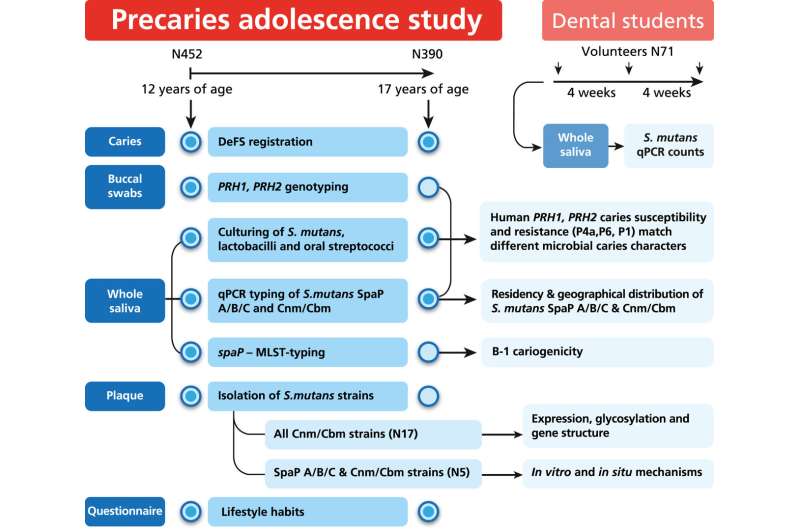This article has been reviewed according to Science X's editorial process and policies. Editors have highlighted the following attributes while ensuring the content's credibility:
fact-checked
trusted source
proofread
Study shows tendency for infection and bacterial flora explain caries

Researchers at Umeå University have for the first time been able to show that individual variation in susceptibility to infection and bacterial flora together explain recurrent caries disease and that others are asymptomatic. The results, which are important for the diagnosis and treatment of caries and other diseases, have been published in the journal eBioMedicine.
In two previous publications in eBioMedicine, a research group at Umeå University has identified three basic types of caries disease through a five-year study on adolescents. Individual variation in the genes PRH1 and PRH2 was shown to predict future caries development and identify individuals with immunodeficiency caries and those with lifestyle caries from poor diet and oral hygiene, respectively. In addition, a bacterial caries type was detected where different types of the caries bacterium Streptococcus mutans matched the individual caries development.
The same research group now shows that the pattern of PRH1- and PRH2-encoded receptors for bacterial adhesion (adhesion) leads to different microbial profiles for caries development in prone and resistant individuals, respectively.
Genetically caries-prone individuals developed caries from a broad profile of bacteria in the normal flora, undesirable individuals from a narrower profile, and resistant individuals from particularly disease-causing types of S. mutans. Infection with S. mutans was stable over time, and fewer individuals were infected with particularly pathogenic bacterial types.
Chronic infections with pathogens such as S. mutans (tooth decay), S. pneumoniae (pneumonia), and S. pyogenes (tonsillitis) are characterized by some individuals developing symptoms and chronic disease, while other infected individuals do not
"The phenomenon of individual variation is now explained by a combination of genetic predisposition and resistance as well as how infectious the bacteria are," says Nongfei Sheng, first author of the article.
Many societies such as the Swedish one are characterized by comparatively high physiological uniformity—for example, up to 90% of children and adolescents brush their teeth morning and evening—which is why genetic differences today play a greater role in caries and other chronic diseases.
"This knowledge is important for better prevention and treatment of these diseases. Resistant individuals who are also free of infection with naturally occurring bacteria and clinical symptoms may have been programmed with a microflora of a particularly benign nature. This is important for the development of pre- and probiotics," says Nicklas Strömberg, last author and leader of the research group.
More information: Nongfei Sheng et al, Human PRH1, PRH2 susceptibility and resistance and Streptococcus mutans virulence phenotypes specify different microbial profiles in caries, eBioMedicine (2024). DOI: 10.1016/j.ebiom.2024.105001

















